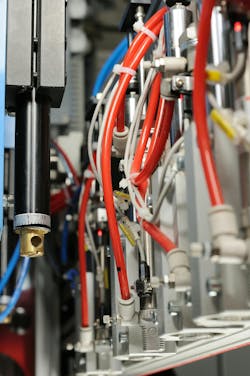From the Editor's Desk: Automation Remains Important Design Focus for Fluid Power
Automation remains a key trend influencing the design of both mobile and industrial machinery. At bauma 2025, a large trade show for the construction and mining equipment industries, automation was one of the event's themes due to its growing role in this sector; as such many companies exhibiting at bauma 2025 showcased their developments in this area.
The National Fluid Power Association (NFPA) is putting together its next technology roadmap which will be focused on industrial applications; initial surveys of stakeholders working in these applications showed automation is a top priority for many industrial markets.
Given the reliance these machinery sectors have on hydraulic, pneumatic and electromechanical solutions, it is no surprise that automation is driving many of the technological developments in the motion control space.
Inclusion of sensors into fluid power systems to improve precision and ensure safe operation is one of the ways the industry is working to meet the needs of automated systems and machines. And in some applications, manufacturers are choosing to instead use electromechanical actuators to achieve their desired performance requirements.
Download our eBook "The Shift from Fluid Power to Electromechanical Technologies" to learn more about how electromechanical solutions are being used in place of hydraulics and pneumatics in some applications as well as tips on how to determine the best option.
As automation is such an important topic to the technology sectors Power & Motion covers, we have decided to dedicate an entire week of new content to subjects related to automation. Starting June 2, you'll be able to read articles and watch video interviews about how automation is being applied in different industries, technologies coming into play to enable automation and a look at advancements in robotic gripper technologies — a key component for many automated systems which commonly utilizes pneumatics.
In 2023, we looked at how automation was impacting hydraulic and pneumatic systems. We'll be diving into the topic again for our week of automation related content in June to evaluate potential impacts to fluid power designs and things have changed or evolved since we first covered the topic.
Have suggestions on automation related topics we should cover in the future? Take our 2-question quiz below to provide your input. The quiz also asks for suggestions on subjects to cover for another week of dedicated content we'll be doing in October on fluid power in industrial applications.
And as always, you can feel free to reach out to me at [email protected] to offer your thoughts on current and future coverage.
About the Author
Sara Jensen
Executive Editor, Power & Motion
Sara Jensen is executive editor of Power & Motion, directing expanded coverage into the modern fluid power space, as well as mechatronic and smart technologies. She has over 15 years of publishing experience. Prior to Power & Motion she spent 11 years with a trade publication for engineers of heavy-duty equipment, the last 3 of which were as the editor and brand lead. Over the course of her time in the B2B industry, Sara has gained an extensive knowledge of various heavy-duty equipment industries — including construction, agriculture, mining and on-road trucks —along with the systems and market trends which impact them such as fluid power and electronic motion control technologies.
You can follow Sara and Power & Motion via the following social media handles:
X (formerly Twitter): @TechnlgyEditor and @PowerMotionTech
LinkedIn: @SaraJensen and @Power&Motion
Facebook: @PowerMotionTech

Leaders relevant to this article:


